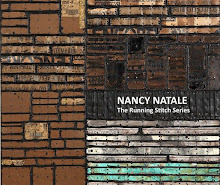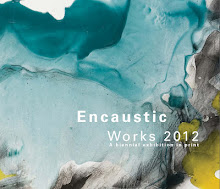So, as I think any artist must, I ask myself from time to time how much I should be influenced by my inspirations. Should I try to copy their work? How much of them should rub off on my own work? Is there a point where my work becomes more about what they want to say than what I do?
 |
| Thinking L.D., 2012, found and invented materials with tacks and encaustic on two panels, 48"H x 60"W (click to enlarge) |
Here is the first piece I've made that somewhat deliberately (in my mind at least) refers to work by one of my Big Three - Leonardo Drew. If I didn't tell you that, would you have guessed? (Of course that's provided you are familiar with his work.) What I was thinking of was his work with boxes put together into a grid, such as his No. 43 of 1994, image below:
 |
| Photo of Leonardo Drew's No. 43 taken from "Existed" (For more about Leonardo Drew, see this blog link to his show at the DeCordova Museum.) |
Now, you can see that my piece looks nothing like his, really, but thinking about his piece is what got me going. His piece has 3-dimensional boxes with rags, found objects and all kinds of stuff in them. My "boxes" are just strips of painted cardboard that frame strips tacked inside them. And my piece is ever so neat, compared to his.
 |
| A detail from Thinking L.D. |
The Creative Process - Try and Try Again
Just to let you in on how the creative process went for me, I first started with "boxes" the same size throughout the panels, made just with strips of natural cardboard painted with clear encaustic. I used them to frame strips of other materials that I tacked down as usual. I ended up with something that looked like a cardboard bookcase. So I scrubbed that.
 |
| Another detail from Thinking L.D. |
The second version enlarged some of the "boxes" but continued them throughout the length of the panels. I thought it still looked like too much cardboard. Then I removed rows of the "boxes" at top and bottom of the panels and put in painted strips that extend the width of each panel. I liked that because they broke up the "box" look, and it turned out that these strips were what really interested me. (After coloring in the cardboard "boxes" with oilstick, I was happier with the overall piece.)
An Unexpected Bonus - A New Direction?
 |
| Half 'n' Half, 2012, found and invented materials with encaustic and tacks, 32"H x 40.5"W |
In fact I liked those painted strips so much that I decided I should make another piece using the leftovers (plus a few more). I put them on a panel and then added that to a panel I had already made in Running Stitch mode. After tweaking the R.S. panel a bit to make the two halves come together more, I was happy. (The bottom panel is one I had made myself so its measurements are a bit off from the standard. However, it turns out that I like the little bit of difference in width between the top half and the bottom half. It gives it sort of an architectural look)
 |
| Detail of painted strips from Half 'n' Half |
A Moral
Don't we expect a moral from any story - or at least a good ending? Well, the moral is that whatever pings your aesthetic brain cells and gets a piece started is a good thing, but being able to see what you've got and where you're going with it is a learned response, I think. And, who knows, a move made out of desperation may be that unexpected path that takes you to artistic nirvana - or not. You'll just have to try it and see.









